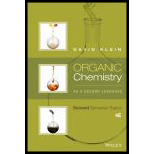
Interpretation:
The expected directing effects that would be observed if the given compound undergoes an electrophilic
Concept Introduction:
Electrophilic substitution reaction is a type of reaction in which a particular group or atom in a compound is replaced by electrophile. An electrophile is a species that is deficient of electrons
Deactivators are electron withdrawing groups attached to the benzenes that have either positive charge or an atom with high electronegativity. They are meta directors.
Activators are electron donating groups attached to the benzenes that have either electron density that is able to push into benzene ring or a lone pair of electrons. They are ortho-para directing.
Halogens are deactivators that are ortho-para directing.
Want to see the full answer?
Check out a sample textbook solution
Chapter 4 Solutions
Organic Chemistry As a Second Language: Second Semester Topics
- Please provide the mechanism with arrows for how this acid chloride was synthesized into an amide from the picture belowarrow_forwardDraw the structure of the major product expected for the following reaction. Hint, the amine acts as a base in this reaction.arrow_forwardOne of the first steps in the synthesis of Risperidone is the electrophilic aromatic substitution shown below. Draw the detailed reaction mechanism for this transformation:arrow_forward
- What is the slow (rate-determining) step in any electrophilic aromatic substitution reaction? Please provide a detailed explanation.arrow_forwardIn the mechanism for electrophilic aromatic substitution with a diazonium ion as the electrophile, why does nucleophilic attack occur on the terminal nitrogen of the diazonium ion rather than on the nitrogen that has the formal positive charge?arrow_forwardExplain which products will be formed as a result of the reaction with the nitronium ion in the electrophilic aromatic displacement reaction by drawing the structures of the compounds given below. methoxybenzene, benzoic acidarrow_forward
- Show the diazo-coupling reactions to form the following dyes from an aniline compound and an aromatic compound for these.arrow_forwardImine formation usually occurs under mildly acidic conditions; however, no acid is addedto this reaction. What is one group present that could facilitate the necessary protontransfers for this reaction?arrow_forwardWhat is the main reaction mechanism for this reductive amination?arrow_forward
- Please do not photo. Propose a possible mechanism for the synthesis of the following compoundarrow_forwardFor each of the following elimination/dehydration reactions, predict the products, including the major product where indicated. Also indicate if the reaction would proceed through E1 or E2.arrow_forwardcomplete the synthesis for the targets shown below ?arrow_forward
 Organic Chemistry: A Guided InquiryChemistryISBN:9780618974122Author:Andrei StraumanisPublisher:Cengage Learning
Organic Chemistry: A Guided InquiryChemistryISBN:9780618974122Author:Andrei StraumanisPublisher:Cengage Learning
